Press release from September 15, 2005
The country needs new landscapes
Innovative concepts for black earth - Soil of the Year 2005
Leipzig. From 20 to 23 September about 100 researchers from 15 countries will be deliberating on the sustainable use of agricultural regions at the Centre for Environmental Research Leipzig-Halle (UFZ). The idea is to reconcile the diverse demands made on modern landscapes: land use and species diversity as well as economic and social functions. A comprehensive digital user handbook developed by the OLANIS software company will be presented for the first time. It is designed to help authorities and landscape planners implement the legal requirements for nature conservation in agriculture. The conference is part of a joint project named "Lebensraum Börde" ("fertile plain habitat"), which aims at protecting nature in intensively used agricultural landscapes and is funded by the environmental foundation Deutsche Bundesstiftung Umwelt (DBU).
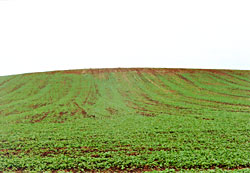
Open agricultural fields. Note the soil erosion
Foto: Dr. B.C. Meyer/UFZ
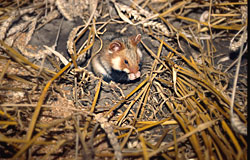
Hamster, threatened with extinction in agricultural landscapes
Foto: K. Mammen, Uni Halle
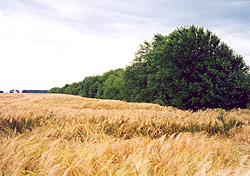
Linear elements in agricultural landscapes such as hedges have multiple ecological functions
Foto: Dr. B.C. Meyer/UFZ
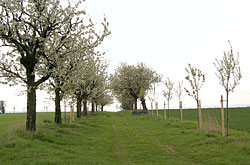
Cherry trees planted by the IUMBO-project along an old field track that provided ecological connectivity
Foto: Dr. B.C. Meyer/UFZ
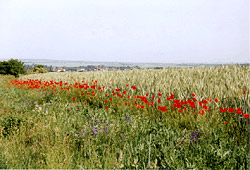
Field margin with weeds
Foto: Prof. H. Mühle/UFZ
When Gerhard Pflock picks up soil from his fields, the dark earth trickles through his fingers: this is chernozem or black earth, the most fertile soil there is and nominated "Soil of the Year 2005". For farmers like him it is a real treasure. Pflock is in charge of crop production at the agricultural enterprise Agrarunternehmen Barnstädt (AUB) on the Querfurter Platte, a landscape in southern Saxony-Anhalt. With around 6 000 hectares, the cooperative is one of the largest agricultural enterprises in Europe. But the fertile black earth of the plain also has a disadvantage: the soil is easily blown away by the wind and washed away by water. This is compounded by the fact that the fields in this region are particularly large, giving the wind free rein. So it is an endangered treasure. This is why the AUB is taking part in a unique pilot project that focuses equally on nature conservation and on farmers’ interests. "The problem of soil erosion can be effectively combated by structures like hedges, uncultivated strips or small woods, as well as by agricultural engineering measures", says project leader Prof. Heidrun Mühle of the UFZ, explaining the basic idea. Agrarunternehmen Barnstädt is investing about 24 hectares, but it is worth the effort. Heidrun Mühle: "The erosion of fertile soil is a problem of major economic importance for the farmers. In some places on the Querfurter Platte ochre colours of loess are already showing through. Those are places where the black earth has already been carried off".
Moreover, the new structures also offer a chance of survival to many endangered animal species, including the brown hare, the red kite and the common hamster. The number of these funny little rodents for instance, has fallen dramatically in recent years because the animals can no longer find enough food after the cereal is harvested and the young hamsters starve in the burrow. In order to prevent this happening in future, a so called hamster protection strip has been designed. It is 20 metres broad and consists of grass and crops that are not mown until some weeks after the harvest. In their pilot project IUMBO (which stands for: integrative realisation of the method of multi-criteria landscape assessment and optimisation at the Querfurt plain), the UFZ researchers are investigating together with colleagues from the Martin Luther University Halle-Wittenberg and the OLANIS software company, what impacts the new landscape structures have on the population of these endangered animal species on the Querfurter Platte. "Multi-criteria landscape optimisation" that’s how the researchers call the aim of an innovative software program designed to improve the quality of future landscape planning with the aid of models. Various criteria, like a reduction of soil erosion, an increase in groundwater recharge and an increase in recreational value are being integrated into the development of new landscape scenarios.
The experiences from the Barnstädt area are relevant to other farmers as well. After all, the Querfurter Platte is not the only region facing these problems.
Other fertile plains, like the Magdeburger plain, the plain between Hildesheim and Wolfenbüttel, the Soester plain and the Kölner Bucht, are facing the same
challenges. In addition, the researchers hope their method will help with planning in other agricultural landscapes.
Tilo Arnhold
More links:
- http://landscape.olanis.de/index.html
- http://iumbo.olanis.de/german/index.html
- http://www.dbu.de/pro/boerde.html
Further technical information from:
Prof. Heidrun Mühle
UFZ, Department of Conservation Research
phone: +49 341 235-2344
E-mail: heidrun.m쎼hle@ufz.de
oder über
Doris Böhme / Tilo Arnhold,
Public Relations of Helmholtz Centre for Environmental Research – UFZ
Phone: +49-341-235-2278
E-mail: presse@ufz.de
